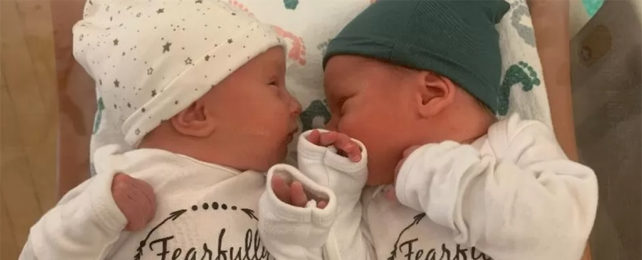Twins Lydia and Timothy Ridgeway were welcomed into the world on 31 October 2022 – more than 30 years after being frozen as embryos. They could well be the longest-frozen embryos to ever result in a live birth, according to official records.
The embryos were created for an anonymous married couple using in vitro fertilization (IVF), and then stored at -196 °C (-323 °F) in liquid nitrogen on 22 April 1992. The IVF process can produce more embryos than are needed, which can then be donated to science or to couples who want children.
The embryos which developed into the twins were donated to the National Embryo Donation Center (NEDC) in Knoxville, Tennessee, before decades later being passed on to parents Rachel and Philip Ridgeway from Portland, Oregon.
Philip would have been five years old when the embryos were first frozen, to put their age into perspective.
"There is something mind-boggling about it," Philip told CNN.
He and wife Rachel already have four other children, all under the age of 10. "We've never had in our minds a set number of children we'd like to have."
The previous record holder for the 'oldest' baby was Molly Everette Gibson, born on 26 October 2020 from an embryo that had been frozen for 28 years. Molly actually took the record from her own sister.
It's possible that an older frozen embryo has been used without its age being recorded. The US Centers for Disease Control and Prevention tracks success rates and other data for reproductive services, but not specifically the ages of frozen embryos.
In this case the Ridgeways picked the embryos from a donor database, which lists certain characteristics about the donors when they're made known. The couple favored donations with lower ID numbers as they would have been the earliest to be entered into the database.
"We weren't looking to get the embryos that had been frozen the longest in the world," Philip told CNN. "We just wanted the ones that had been waiting the longest."
Embryos can be frozen pretty much indefinitely, though the survival rate after thawing is around 80 percent, and only a fraction of the transferred embryos result in live births. In this case, five embryos were thawed, and three were viable enough to be transferred, resulting in two live births.
In spite of spending so much time in deep freeze, the children are expected to be as healthy as any other person who started life as a stored embryo. It's more the age of the embryo donor and recipient that make a difference to the procedure's success.
Now, after a long wait, life can begin properly for Lydia (born weighing 5 pounds, 11 ounces [about 2.6 kilograms]) and Timothy (born weighing 6 pounds, 7 ounces [about 2.9 kilograms]) – both "good-size babies" in the words of their mother Rachel.
The team at the NEDC is hoping that other prospective parents will be encouraged to come forward after the births of Lydia and Timothy. The organization has now helped in the birth of more than 1,200 babies using donated embryos.
"The decision… to adopt these embryos should reassure patients who wonder if anyone would be willing to adopt the embryos that they created 5, 10, 20 years ago," NEDC physician John David Gordon, who performed the embryo transfer, told the BBC.
"That answer is a resounding yes!"
